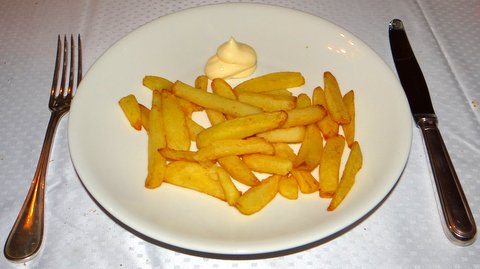
Belgian Fries (known as “Vlaamse friet” or simply “patat” in the Netherlands) are very popular in both Belgium and the Netherlands. The main difference with French fries is that they are thicker. Belgian fries should be freshly cut, fried twice, fluffy on the inside, crispy on the ouside, have a distinct potato taste, and are 1 cm (1/2 inch) thick. Belgian fries are usually served in a paper cone when you buy them from a street vendor, but at home I just serve them on a plate.
For the best taste, real Belgian fries must be fried in beef tallow (ossewit, rundvet, blanc de boeuf). Besides the flavor, this also has the advantage that the smoke point of beef tallow (255C/490F) is higher than of most vegetable oils used for deep frying (e.g. peanut oil 225C/440F), so the fat does not degenerate as much at the temperatures (up to 190C/375F) needed to fry.
In the Netherlands the use of beef tallow (ossewit) for frying has all but disappeared, thanks to health freaks claiming the low-cholesterol benefits of using vegetable oil. They are of course right that frying in vegetable oil is better for your cholesterol, but unlike vegetable oil, beef tallow does not contain any trans fat so it is not clear-cut which is more healthy. Fries are quite fatty in any case, but like I always say: I’d rather eat less of a tasty food than not eat it at all. So if you eat fries only once in a while like I do, I’d recommend to use beef tallow. Having said this, the recipe below will also work fine with vegetable oils with a high smoke point such as peanut oil. You will just miss out on the better taste. (Although ossewit is hard to find in Dutch supermarkets, some Albert Heijn or Jumbo supermarkets still carry it. Thanks to Kristien for locating ossewit in the AH Assendelft!)
The other important ingredients is of course the potato. Floury potatoes (“kruimig”) are best for fries. Since they contain less water than waxy (“vastkokend”) potatoes, the fries will be more crunchy on the outside and more fluffy on the inside. Large potatoes will give you longer fries and are less work (less peeling for the same weight of fries). The sugar content of potatoes is lowest when they have just been harvested, and increases slowly while they are stored. The sugar content increases more quickly when potatoes are stored in a colder place (e.g. your refrigerator). Since a higher sugar level will make the fries brown faster, you will get lighter fries with new potatoes and browner fries with older potatoes or potatoes that have been stored in the refrigerator.
Belgian Fries are usually served with mayonnaise, not with ketchup and definitely not with vinegar.
Ingredients

large floury potatoes (about 250 grams / .6 lbs per serving)
3 kilograms (6-7 lbs) beef tallow (substitute with 3 liters/quarts vegetable oil with a high smoke point)
salt
Preparation

You can use either a pot on the stove or a dedicated fryer for this. I like to use a dedicated fryer because it has the handy basket, but the temperature control is not as good as a pot on the fire.
Start by heating the beef tallow. Beef tallow is solid at room temperature, so you will need to melt it first.
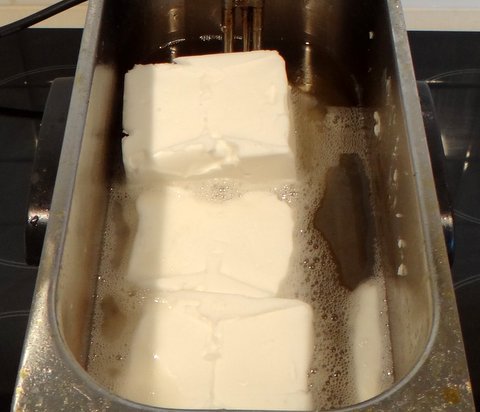
You only need to heat it to 140C/280F for the first fry.

Peel the potatoes and cut into long sticks with a thickness of 1 cm (.4 inch) or a bit thicker if you like.

Let the potato sticks soak in cold water for 10 minutes or so to remove some of the starch.

Drain and pat dry with a clean kitchen towel.

Make sure the temperature is 140C/280F before you add the potatoes.
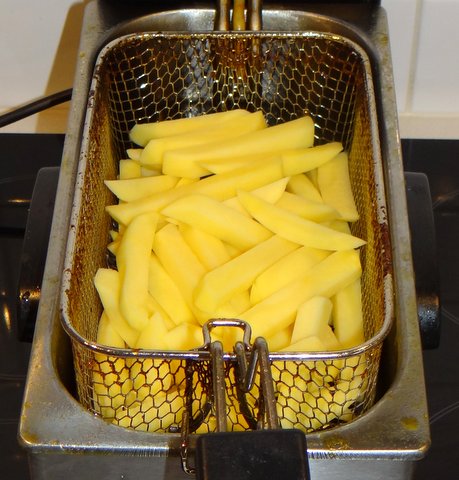
A basket is easy to lower and lift all the fries at the same time, but you could also use a deep fry skimmer to lift the fries.
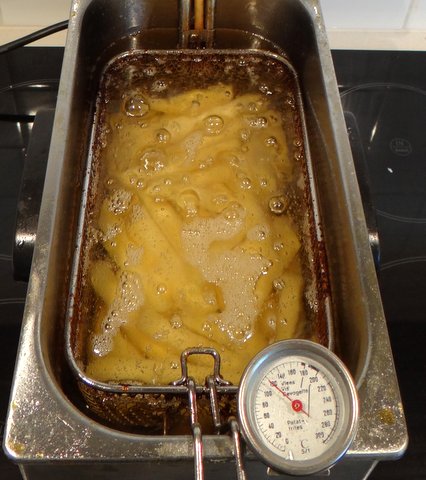
Lower the potatoes into the fat and make sure the temperature stays between 120C/250F and 140C/280F.
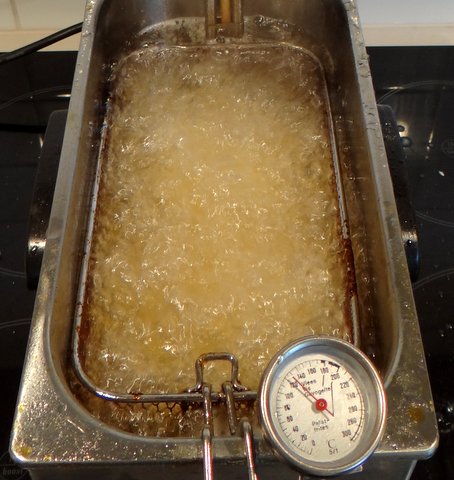
‘Boil’ the potatoes in the hot fat, uncovered, for 5 minutes. Not covering is important so the water that will come out of the potatoes as steam can escape.
In Belgium it is said that fries should ‘swim’, i.e. use enough fat so the temperature does not drop too much when you add the fries.
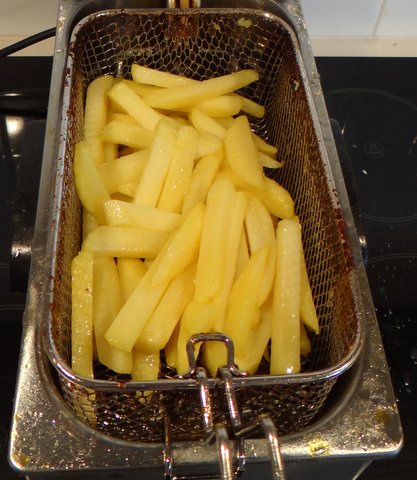
The first fry is done when the fries are slightly golden and slightly limp. In Belgium it is said that they are done when they ‘sing’, referring to the whistling sound they make at this point.
Here comes a very important step to obtain fries that are crispy on the outside and fluffy on the inside. Shake the fries well to remove as much of the fat as possible. Line a tray with paper towels, and spread out the fries. Let the fries cool to room temperature, and then refrigerate them for at least half an hour (or up to a day). The cooling and drying is important to make them crispy.

When you are ready to finish the fries, heat up the beef tallow to 190C/375F and add the fries. Monitor the temperature to keep it between 180C/350F and 190C/375F.
Do not fry more than about 500 grams (1.1 lbs) of fries at the same time, otherwise the temperature of the fat will drop too far. Fry in batches if needed, or use more fat (the fat should be at least 5 times the amount of fries).
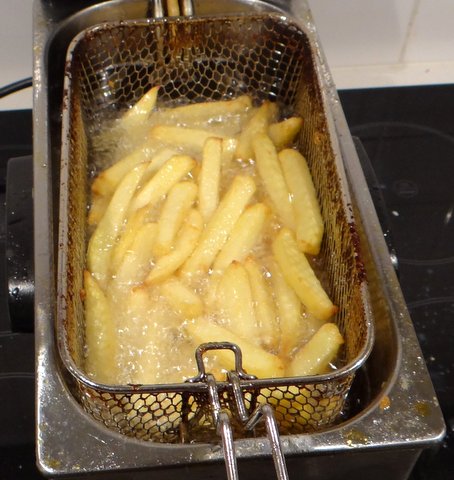
Shake the fries now and then to make sure they don’t stick together.

Fry for 2 minutes until the fries are crispy and golden brown (as explained above, the final color will depend on the time of the year).
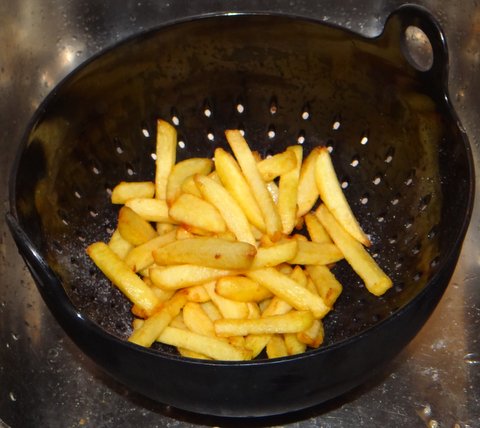
Put the fries into a colander in the sink (because fat will come out and that is easier to clean that way) and season with salt.

In Belgium it is also said that fries should ‘spring’. This refers to the necessity to let the fries ‘jump’ for a bit. That is the the final important step to ensure crispy fries: toss them into the air a few times (making sure to catch them again in the colander…) so the salt is distributed evenly and the excess moisture can escape. That moisture would otherwise make the fries soggy.
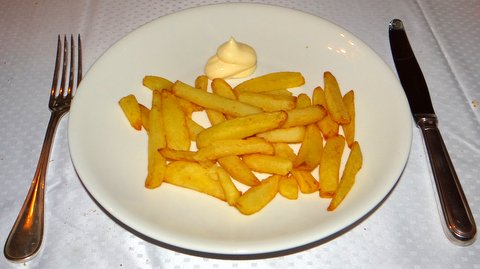


I very much prefer Belgian fires over pommes frites. I like my fires to be on the meaty side, so to speak. And double frying is the only way to go, in my humble opinion. I would prepare these far more often but for the leftover fat. Disposing of it can pose a problem. Even so, I’ll deal with it just to get some freshly made Belgian fires. They are soo good! Just look at those in your photos, Stefan!
LikeLike
Thanks, John. You can actually re-use the beef fat a dozen times or so, and it keeps well at room temperature (if kept airtight).
LikeLike
That’s pretty much the way ‘chips’ were cooked in the traditional English Fish and Chip shops when I was a kid in England … I doubt they use beef fat there anymore either. Sad!
LikeLike
For me “chips” is a confusing term as that is here the word for deep-fried thin slices of potato (“crisps” in the UK).
You are probably right that beef fat isn’t used much in the UK anymore either.
LikeLike
You are evil! You are making me salivate just at looking at the picures!
LikeLike
Sorry 😉
LikeLike
Cooling and tossing. That’s where I have been going wrong. You are forgiven for the one slightly dodgy photo. I don’t know how you took it!
Best,
Conor
LikeLike
It’s actually my husband who’s doing the tossing in the photo. It was hard to take this photo anyway, as there is some time between releasing the shutter and actually taking the photo.
LikeLike
Great post. Hard for us to get tallow for frying, but it does make a difference!
LikeLike
There is a Belgian webshop that ships to the USA, but the shipping cost is prohibitive (almost $80 for 22 lbs).
LikeLike
Love the technique. Cooling and double frying is the key. Sadly, Baby Lady won’t let me have a deep fat fryer. 😦 Heart disease runs in my family and I already push the limits. I do love fried foods.
LikeLike
Once a year won’t kill you!
LikeLike
If I ever got a deep fat fryer, I promise you it wouldn’t be a once a year thing. You can do so many things so much simpler with a deep fat fryer and we haven’t even started talking about donuts or beignets. Making me fry in a dutch oven is a real discouragement which apparently works because I fry things perhaps once a year. 😉
LikeLike
A deep fat fryer is not known to be a culinary kitchen tool in my country, so many people here are surprised when they find out I own one. But like you said: it is so much simpler, even though the temperature control is less precise.
LikeLike
This recipe was a nice review for me. I render my own tallow from beef fat obtained from my local supermarket butcher. It takes some time to make it but it lasts a very long time when frozen. Your fries look outstanding!
LikeLiked by 1 person